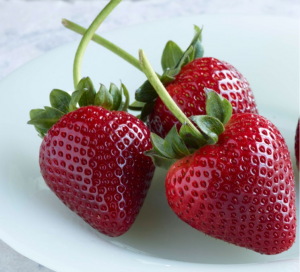– Organic Strawberries (Driscoll’s)
One of my favourite fruits are strawberries, sweet and fun and they carry a great deal of antioxidants, and the best part of Driscoll’s is that they are organic:
“As defined by the USDA National Organic Program, organic food is produced by farmers who emphasize the use of renewable resources and the conservation of soil and water to enhance environmental quality for future generations. Before a product can be labeled “organic,” a government-approved certifier inspects the farm where the food is grown to make sure the farmer is following all the rules necessary to meet USDA organic standards.”
– http://www.driscolls.com/berries/organic-berries/what-is-organic
So there is clearly a saving of fossil fuel, by using renewable energy sources, and being conscious about the environment in which their strawberries are grown in.
I found this link really interesting. It is for the Driscoll’s website, and if you insert the label code on your strawberry package, you can find out exactly where your strawberries came from.
http://www.mydriscolls.com
Mine came from California, so considering they are deemed organic, we also must realize that the packaging of strawberries is made of plastic, however, I always make sure to recycle the packaging, so it is considered a renewable source. However, the creation of this packaging I speculate would be done in factories and then transported to a factory where the packaging occurs and is shipped around the world. So my question- how organic are these strawberries?
– Avocado
I am speculating that my avocado was from California, as most of them sold locally are grown in California. After doing some digging I found out that in fact they are hand grown and hand picked. This is a huge saving of fossil fuel emission, and in a way organic as Californian avocadoes deem to use no chemical pesticides and fertilizers.
Once picked, avocadoes are transported by tractor or truck- Which is fuel operated. Thinking about how many avocadoes are sold every single day, its clear that using tractors and trailers is not the most eco-friendly way to transport them. As Manning suggests, soil “is as rich in energy as an oil well” – and this holds some truth. As tractors and trucks drive through the farms, oil seeps into the land and into the farming areas. So, as Manning also asserts- each calorie we eat= 1 calories of oil or more. The term organic just seems politically incorrect.
– Grilled Chicken
I made homemade grilled chicken, with a few simple herbs and spices. The chicken breast was purchased frozen from Safeway, in a warehouse type package. According to Safeway’s website they claim to produce their poultry in California, Oregon, Washington and Pennsylvania.
“Birds are raised on a soft bed of rice hulls and are given approximately one square foot per bird in which to roam freely in the poultry house, and the outdoor pen space is 50% to 100% the size of the inside house. This is significantly more space than is used for growing conventional chickens.” http://www.safeway.com/ShopStores/Open-Nature-FAQ-Meat.page
I really appreciate that Safeway claims to raise and care for their animals in safe and up to standard facilities, and also adhere to the Humane Slaughter Act. The chickens are fed corn and corn gluten meal along with soybean meal and regular minerals and vitamins. When we go back and think corn and soy bean, and wheat, we can apply Manning’s reference to the Amber Revolution to this:
“Plant breeders tinkered with the architecture of these three grains so that they could be hypercharged with irrigation water and chemical fertilizers, especially nitrogen. This innovation meshed nicely with the increased “efficiency” of the industrialized factory-farm system. With the possible exception of the domestication of wheat, the green revolution is the worst thing that has ever happened to the planet.”
In thinking that chickens may be grain fed, we also must realize what those chickens are fed at the farm and that these grains probably contain a great deal of chemical fertilizers. The grains that grow in soil, Manning refers to:
“as rich in energy as an oil well”
We are eating a lot of oil without even knowing it..
Chickens are raised in farms, where temperature remains standardized and a warm climate is kept. Considering just how much poultry is produced for consumption, the amount of energy used to heat farms would be astronomical. This is a huge take-up of energy, where Manning explains that
“It takes 5.5 gallons of fossil energy to restore a year’s worth of lost fertility to an acre of eroded land” – thats a lot of energy lost
Once in factory after being transported by truck (which also burns fossil fuels), the butchering process of chickens also uses huge amounts of energy, where chickens are butchered and processed on assembly line. The amount of machinery used to operate and achieve this certainly burns a lot of fossil fuel. Consider if this was done by hand, we would never have enough chicken for our consumption needs. Our demand for quickness of products forces the quick and environmentally unconscious production of things like chicken.
Frozen chicken must stay cold and frozen in the grocery store, and so to operate the freezers and fridges in the grocery store is immense. The chicken is packaged in cardboard boxes, which I am always sure to recycle. Seems like that is the only upside to buying frozen chicken when considering the environment.


